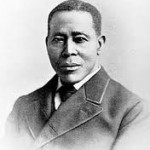 By James Oliver Horton
By James Oliver Horton
One of the most effective organizers of a formal segment of the Underground Railroad was a free African American named William Still. His father, Levin Still, had purchased his own freedom. His mother, Sidney, and his two brothers and two sisters, remained enslaved in Maryland, however. Sidney and the children managed to escape once but were captured and returned to Maryland.
Aware that all five could not escape together again, Sidney made one of the most difficult decisions any mother could make. In 1807, leaving the two older boys behind with their grandmother (who was also a slave), Sidney struck out for freedom again. This time, she took only the two younger girls. They succeeded, and she was reunited with her husband. To conceal their identities, they changed Sidney’s name to Charity and the family name to Still. Fourteen years later, William Still was born free in New Jersey.
At age 23, Still moved to Philadelphia, where he worked as a mail clerk and a janitor for the Pennsylvania Anti-Slavery Society. He educated himself, became a businessman, and eventually was appointed head of the General Vigilance Committee of Philadelphia, a group dedicated to defending and assisting fugitive slaves seeking refuge in the city.
Over the next few years, Still and his associates worked to organize an extensive network of safe houses and conductors that soon became the foundation of one of the most effective Underground Railroad systems in the country. The group raised money to help fugitives and kept an eye on the movements of slave catchers throughout Pennsylvania. Still’s work became quite personal when he was introduced to a middle-aged man from Alabama in search of information.
In a letter written on August 8, 1850, from his office in Philadelphia, William Still described an amazing encounter with a man who called himself Peter Freedman. Freedman sought information about his family, who had come north some years before. As his story unfolded, Still recognized much of the detail. “My feelings were unutterable,” he said. “I could see in the face of my newfound brother, the likeness of my mother.” Peter Freedman was Still’s brother. He had been left in slavery when his mother escaped. The brothers had never met.
“I told him I could tell him all about his kinfolk,” Still recalled. The next day, Peter was reunited with his family. Their father was dead by this time, but Freedman met five brothers and three sisters whom he had never known. “I shall not attempt to describe the feelings of my mother and the family on learning the fact that Peter was one of us,” Still wrote.
The family’s struggle was not over, however. When Freedman left Alabama, he had left behind a wife and children whom he was determined to free.
Members of the Underground Railroad secured their escape to Indiana, but they were recaptured and returned to slavery. When Freedman attempted to purchase their freedom, their master demanded the seemingly impossible sum of $5,000. With the help of Still’s abolitionist friends, he began a lecture tour, telling the story of his enslaved family to raise money for their freedom. It took four years of fundraising. In October 1854, he accomplished his goal. Once free, Peter Still (the name he now used) and his family settled on a 10-acre farm in Burlington, New Jersey, where they lived until Peter died of pneumonia in 1868.
William Still continued his Underground Railroad activities and worked for civil rights in Philadelphia throughout the Civil War. During and after the war, he raised funds to assist former slaves who had gained their freedom in the South. He also served on Philadelphia’s board of trade and helped establish a Young Men’s Christian Association (YMCA) for the city’s African Americans. In his work, Still met Frederick Douglass and became good friends with Harriet Tubman. He kept detailed records of his organization’s activities and of the almost 800 fugitives it helped in the years before the Civil War ended slavery. In 1872, he published his records along with the stories of hundreds of runaways in The Underground Railroad. William Still died in 1901.
Many descendants of the Still family continue to live in southern New Jersey, where they hold regular family reunions. Their story, like that of the Underground Railroad and the story of the abolition movement, is a freedom story, an all-American story of the many who refused to accept the denial of freedom.
Original Article: http://www.slaveryinamerica.org/narratives/bio_william_still.htm







